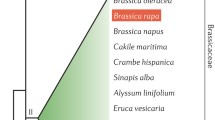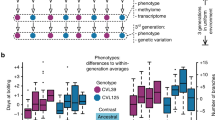Abstract
Arabidopsis thaliana has been used as a model plant for molecular genetics studies. Recently, Arabidopsis has been utilized in an increasing number of ecological and evolutionary studies. These studies are beginning to explain three “black boxes” of ecology: the nature of the mutations responsible for phenotypic variation, female–male interactions in the pistil, and the genetic basis of speciation. Among the advances are the inclusive fitness of haploid gametophytes, the testing of the arms-race model, morphological diversity, and reproductive isolation. Important methods include quantitative trait locus (QTL) mapping and molecular population genetics. Most significantly, natural variations of various aspects are now available via the taxonomic revision of its closely related species, and by the worldwide collection of accessions. Some conspicuous works using maize, Drosophila, and other species will be also discussed.
Similar content being viewed by others
Author information
Authors and Affiliations
Additional information
Received: June 1, 2002 / Accepted: October 15, 2002
Acknowledgments I would like to express my deepest gratitude to Prof. K. Okada for supporting this research. I thank the organizers of the symposium for fruitful discussion, T. Yahara and M. Kanaoka for critical reading, T. Araki and T. Kenta for valuable discussions, and members of the Okada laboratory for technical assistance and discussion. The work was supported by JSPS Research Fellowships for Young Scientists.
Rights and permissions
About this article
Cite this article
Shimizu, K. Ecology meets molecular genetics in Arabidopsis . Popul Ecol 44, 0221–0233 (2002). https://doi.org/10.1007/s101440200025
Issue Date:
DOI: https://doi.org/10.1007/s101440200025




